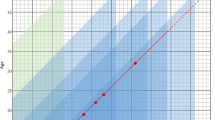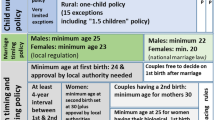Abstract
During the last decade, family formation patterns in Spain have undergone a process of substantial transformation. Younger cohorts are increasingly postponing marriage and, once they enter marriage, they tend to delay childbearing. Partly as a result of these timing shifts, period measures such as total fertility rates are likely to underestimate “true” fertility levels. This study focuses on the first stage of family formation: the transition to motherhood. Following a birth interval approach, the analysis depicts recent trends and differentials in the timing of first birth and explores the role of premarital pregnancies and contraceptive practice on first interval dynamics.
Résumé
Durant la dernière décennie en Espagne, les types de constitution de la famille ont connu de substantielles transformations. Les plus jeunes cohortes prolongent leur célibat et, une fois mariées, tendent à retarder leurs naissances. En partie comme un effet de ces changements temporels, les mesures transversales, telles que la fécondité cumulée, sous-estiment vraisemblablement les “vrais” niveaux de la fécondité. Cette étude concentre son attention sur la prémière étape de la formation des familles: la transition vers la maternité. En utilisant une approche longitudinale, on analyse les tendances et les différences dans le calendrier de la première naissance et l'on explore le rôle des grossesses prémaritales et des pratiques contraceptives sur la dynamique de l'intervalle entre mariage et première naissance.
Similar content being viewed by others
References
Agüero, I. and Olano, A., 1980. La evolución reciente de la fecundidad en España. Revista Española de Investigaciones Sociológicas, 10: 121–150.
Aitkin, M. and Clayton, D., 1980. The fitting of the exponential, weibull and extreme value distributions to complex censored survival data using GLIM. Applied Statistics, 29: 156–163.
Alcobendas, P., 1984. The employment of women in Spain. Commission of the European Communities, Luxembourg.
Allison, P.D., 1982. Discrete-time methods for the analysis of event histories. In: S. Leinhardt, ed. Sociological Methodology 1982. Jossey-Bass, San Francisco, CA: 61–98
Arango, J., 1987. La modernización demográfica de la sociedad española. In: J. Nadal, A. Carreras and C. Sudrià, eds. La economía española en el siglo XX: una perspectiva histórica. Ariel, Barcelona: 201–236.
Baker, R.J. and Nelder, J.A., 1978, The GLIM-system, Release 3. Numerical Algorithms Group, Oxford.
Becker, G., 1981. A Treatise on the Family. Harvard University Press, Cambridge, MA.
Bernhardt, E.M., 1989. Fertility and employment. Stockholm Research Reports in Demography No. 55, University of Stockholm.
Blake, J. and Del Pinal, J., 1980. Educational attainment and reproductive preferences: theory and evidence. In: C. Hohn and R. Mackensen, eds. Determinants of Fertility Trends: Theories Re-examined. Ordina Editions for IUSSP, Liège: 59–78.
Blayo, C., 1987. La fécondité en Europe depuis 1960: convergence ou divergence? Plenaries of the European Population Conference 1987. Central Statistical Office of Finland, Helsinki.
Bloom, D.E., 1984. Delayed childbearing in the United States. Population Research and Policy Review, 3: 103–139.
Bumpass, L.L., Rindfuss, R.R. and Janosik, R., 1978. Age and marital status at first birth and the pace of subsequent fertility. Demography, 15: 75–86.
Castro Martin, T., 1990. Recent patterns of family formation in Spain: a sequential analysis of parity transitions. PhD dissertation, Department of Sociology, University of Wisconsin-Madison, WI.
Chen, R. and Morgan, P., 1991. Recent trends in first birth timing in the United States. Demography, 28, 523–533.
Cochrane, S., 1983. Effects of education and urbanization on fertility. In: R. Bulatao and R. Lee, eds. Determinants of Fertility in Developing Countries, Vol. 2. Academic Press, New York: 587–626.
Cox, D.R., 1972. Regression models and life tables. Journal of the Royal Statistical Society, Series B, 34: 187–220.
Cramer, J.C., 1980. Fertility and female employment: problems of causal direction. American Sociological Review, 45: 161–190.
Delgado Pérez, M. and Fernández Cordón, J.A., 1989. La fecundidad en España desde 1975. Documento de Trabajo 2, Instituto de Demografía, Madrid.
Díez Nicolás, J. and de Miguel, J., 1981. Control de natalidad en España. Fontanella, Barcelona.
Feeney, G., 1983. Population dynamics based on birth intervals and parity progressions. Population Studies, 37: 75–89.
Fernández Cordón, J.A., 1986. Análisis longitudinal de la fecundidad en España. Actas del simposio internacional sobre tendencias demográficas y planificación económica, Ministerio de Economía y Hacienda, Madrid: 49–75.
Gilks, W.R., 1986. The relationship between birth history and current fertility in developing countries. Population Studies, 40: 437–455.
Hicks, W.W. and Martínez-Aguado, T., 1987. Las determinantes de la fecundidad dentro del matrimonio en España. Revista Española de Investigaciones Sociológicas, 39: 195–212.
Hobcraft, J. and Rodríguez, G., 1980. Some methodological issues on life-table analysis of birth histories. Paper presented at the IUSSP seminar on analysis of maternity histories, London.
Hobcraft, J. and Murphy, M., 1986. Demographic event history analysis: a selective review. Population Index, 52: 3–27.
Hoem, J.M., 1985. The impact of education on modern union initiation. Stockholm Research Reports in Demography No. 27, University of Stockholm.
Hoffert, S.L., 1984. Long-term economic consequences for women of delayed childbearing and reduced family size. Demography, 21: 141–155.
Jones, E.F., 1982. Socio-economic differentials in achieved fertility. WFS Comparative Studies 21, ECE Analysis of WFS Surveys in Europe and USA, International Statistical Institute, Voorburg, Netherlands.
Khoo, S. and Krishnamoorthy, S., 1985. Changes in the timing of births in Melbourne, Australia. Journal of Biosocial Science, 17: 235–247.
Lamas, L., 1985. Birth Intervals, parity-specific fertility and stable populations. PhD dissertation, Department of Sociology, University of Wisconsin-Madison, WI.
Leasure, W., 1963. Factors involved in the decline of fertility in Spain 1900–1950. Population Studies, 16: 271–285.
Linhard, J., 1983. Family planning in Spain. International Family Planning Perspectives, 9: 9–14.
Livi Bacci, M., 1968. Fertility and nuptiality in Spain from the late 18th to the early 20th century. Population Studies, 22: 83–102, 211–234.
Loh, S. and Ram, B., 1990. Delayed childbearing in Canada: trends and factors. Genus, 66: 147–161.
Marini, M.M., 1984. Women's educational attainment and the timing of entry into parenthood. American Sociological Review, 49: 491–511.
Monnier, A., 1990. Actualité démographique européenne. Population et Société No. 250, INED, Paris.
Moreno-Navarro, L., 1987. Fertility change in five Latin American countries: a covariance analysis of birth intervals. Demography, 24: 23–41.
Muñoz-Pérez, F., 1987. Le déclin de la fécondité dans le sud de l'Europe. Population, 6: 911–942.
Namboodiri, K. and Suchindran, C.M., 1987. Life table techniques and their applications. Academic Press, Studies in Population, New York.
Newman, J.L. and McCulloch, C.E., 1984, A hazard rate approach to the timing of births. Econometrica, 52: 939–961.
Ní Bhrolcháin, M., 1988. The contraceptive confidence idea: an empirical investigation. Population Studies, 42: 205–225.
Palloni, A. and Sorensen, A., 1986, Methods for the analysis of event history data. Center for Demography and Ecology Working Paper No. 86-36, Center for Demography and Ecology, University of Wisconsin-Madison, WI.
Reher, D.S., 1991. Marriage patterns in Spain, 1887–1930. Journal of Family History, 16: 7–30.
Rindfuss, R.R. and Bumpass, L.L., 1978. Age and the sociology of fertility: how old is too old? In: K. Taeuber, L. Bumpass and J. Sweet, eds. Social Demography. Academic Press, New York.
Rindfuss, R.R., Palmore, J.A. and Bumpass, L.L., 1982. Selectivity and the analysis of birth intervals from survey data. Asian and Pacific Census Forum, 8: 5–16.
Rindfuss, R.R., Morgan, S.P. and Swicegood, G., 1988. First Births in America: Changes in the Timing of Parenthood. University of California Press, Berkeley, CA.
Rodríguez, G., Hobcraft, J., McDonald, J., Menken, J. and Trussell, J., 1984. A comparative analysis of birth intervals. WFS Comparative Studies No. 30, International Statistical Institute, Voorburg, Netherlands.
Ryder, N.B., 1980. Components of temporal variations in American fertility. In: R.W. Horns, ed. Demographic Patterns in Developed Societies. Taylor Francis, London: 11–54.
Ryder, N.B., 1982. Progressive fertility analysis. WFS Technical Bulletin No. 8, International Statistical Institute, Voorburg, Netherlands.
Sáez, A., 1979. La fécondité en Espagne depuis le début du siècle. Population, 6: 1007–1022.
Sweet, J.A., 1981. Work and fertility. In: G.L. Fox, ed. The Childbearing Decision. Sage, New York: 197–218.
Teachman, J.D. and Polonko, K., 1985. Timing of the transition to parenthood: a multidimensional birth-interval approach. Journal of Marriage and the Family, 47: 867–879.
Trussell, J., Martin, L., Feldman, R., Palmore, J., Concepcion M. and Bakar, D., 1985. Determinants of birth interval length in the Philippines, Malaysia and Indonesia: a hazard-model analysis. Demography, 22: 145–168.
Tsui, A.O., 1982. The family formation process among US marriage cohorts. Demography, 19: 1–28.
Walter, C.A., 1986. The Timing of Motherhood. Lexington Books, Lexington, MA.
Wilkie, J.R., 1981. The trend toward delayed parenthood. Journal of Marriage and the Family, 43: 583–591.
Author information
Authors and Affiliations
Additional information
The views expressed in this article are those of the author and do not necessarily represent those of the United Nations.
Rights and permissions
About this article
Cite this article
Martín, T.C. Delayed childbearing in contemporary Spain: trends and differentials. Eur J Population 8, 217–246 (1992). https://doi.org/10.1007/BF01797211
Received:
Revised:
Issue Date:
DOI: https://doi.org/10.1007/BF01797211




